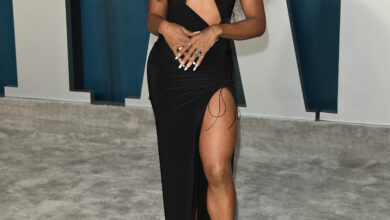Sustainability, Sports, the Super Bowl and the Overproduction of Merch

With its staggering stats about waste, fashion is seen as a climate culprit. But what about the overproduction of entertainment and sports merch — like what goes down for the Super Bowl?
In the fall of 2019, I attended a panel discussion hosted by the British Fashion Council on the last day of London Fashion Week (LFW). Centred on the topic of sustainability and fashion, it included designer Phoebe English; model and environmental activist Arizona Muse; and Bel Jacobs, a former fashion editor who now works with the environmental protest group Extinction Rebellion. I was eager to hear what the informed and illustrious speakers had to say about how the industry can do its part by being more sustainably minded. (I’ve started using this phrase instead of the word “sustainable” since success is hard to measure or even define.)
RELATED: Feeling Existential Dread Because of Climate Change? Here’s What You Can Do
I listened patiently while the usual factoids were listed off. You know the ones — like the 2018 study stating that the fashion industry contributes to around 10 per cent of all greenhouse gas emissions. But when Jacobs, in an effort to stop the promotion of wasteful practices, called for an end to LFWs, it gave me pause, prompting me to raise my hand during the Q&A period and ask “Are there any plans to call for a boycott of the Super Bowl?”
My query seemed to catch some of the panellists off guard, and some anger churned within me when it was essentially deflected and redirected back to the evils of the fashion industry. When talking about my feelings post-event with others who weren’t in attendance, I was occasionally met with churlish astonishment that I got this upset over the fact that fashion seems to bear the brunt of our climate crisis activism when the sports industry, for example, is supremely environmentally damaging as well. Or, folks were gobsmacked that they hadn’t thought much about the inconsistency at all.
It’s easy to see why that is: It’s a generally unpopular observation. Since the sustainability conversation is anchored by alarming statistics, here’s one for your consideration: As of this writing, Google Trends reported that searches for “sustainability fashion” happen nearly five times more frequently than searches for “sustainability sports” — and that’s just one industry other than fashion that you could choose. There’s also entertainment (which was meagre by comparison, with one twelfth of the search power), automotive and travel, to name a few. The variety of climate-crisis villains is vast, yet the outrage directed toward them is palpably sparser.
I’m galled by this discrepancy because not only am I a “fashion person” — via both vocation and a personal investment in vestiary self-expression since childhood — but my interest in the concept of sustainability and design has made me realize that intersectionality and scope-broadening are important. To put it another way, I’m weary of standing outside a house that’s on fire (the earth, in this case) and focusing wholly on one method of putting it out when there are plenty at our disposal.
When I hear a statistic like the aforementioned about the fashion industry’s emissions, it makes me wonder: What’s the breakdown when it comes to garments crafted by someone like Phoebe English versus those by a company like Shein? Or, to the point of this story, are we going to continue pretending that this number doesn’t include the creation of sports gear for both players and fans? And what about uniforms for fast-food employees and medical scrubs? If all apparel falls under the category “fashion,” why is the fashion industry solely taking the blame?
And where are the venomous TikToks — an all-too-common form of commentary lobbed at the great big “fashion bogeyperson” on the daily — about the tens of millions of meat products sold at sporting events every season when we know that a study released last year found that 60 per cent of greenhouse gas emissions are caused by animal agriculture? (I can’t recall a time I was given a red hot — let alone asked to pay an exorbitant price for one — during LFW, FWIW.)
Unlike with fashion events, at any given moment of the day across the entire world, sports are being played both professionally and at an amateur level. Players need uniforms, and spectators are buying everything from food to foam fingers. On top of that, consider that for every championship game played, clothing and other paraphernalia are created with the expectation that one team is going to win.
What happens to the losing team’s commodities? The website Mental Floss attempted to answer this question in a story that includes a staggering stat about the 2007 Super Bowl: “Based on strong sales after the Chicago Bears’s 2007 NFC Championship win…Sports Authority printed more than 15,000 shirts proclaiming a Bears Super Bowl victory well before the game even started. And then the Colts beat the Bears, 29–17.” After reading the entire article, though, I came away from it feeling like we’re all losers here because what follows these lines is a photo of a group of smiling children wearing much-too-large sports jerseys that were donated to them by the evangelical Christian organization World Vision, which previously facilitated the distribution of unused products from suppliers to communities in need around the world.
Now, you’ve likely heard of markets and landfills, particularly in the Global South, that are choked with garment and accessories castoffs from countries like Canada and the United States. I see it posted about vigorously alongside calls to reframe our consumption of fashion goods. But, to date, I have never seen this reality dissected by way of a cleverly designed infographic social post with regard to sports swag or the promotional spoils that come with blockbuster movies, the latest Netflix releases or concert tours. That photo truly crystallized what I’ve been feeling this entire time when it comes to where we lay the blame of waste as well as what we do with it.
I can only speculate as to why this compartmentalizing, or sheer, wilful ignorance, is a reality. Part of my supposition comes from knowing that fashion’s reputation as an allegedly protective domain for women and members of the LGBTQIA2S+ community makes it an easy target for undue scrutiny in the distressingly bigoted world we live in.
It’s also seen as frivolous — by many people for multiple reasons — despite what a lot of us know about its ability to help us manifest our inner selves to the world or unite us by community or subculture. And perhaps most importantly, sports and entertainment — specifically the kind that requires energy-sucking productions and rampant global travel — are industries that have been designed to alleviate our daily dismay. We don’t think about our anxiety or depression when we’re watching “our team” win a game. Such distractions are salves for the trials and tribulations of the human condition.
But fashion, especially nowadays, is increasingly an echo chamber and outlet for our existential angst. Whether it’s Balenciaga’s snow-covered runways or the brands that launch on the daily touting a new miracle textile du jour, the industry has unfortunately attempted to right wrongs by creating more hype and more products. But at the very least, there’s some self- — and communal — awareness about how much needs to change in this sphere; I cannot say the same for the Super Bowl.
Source link






